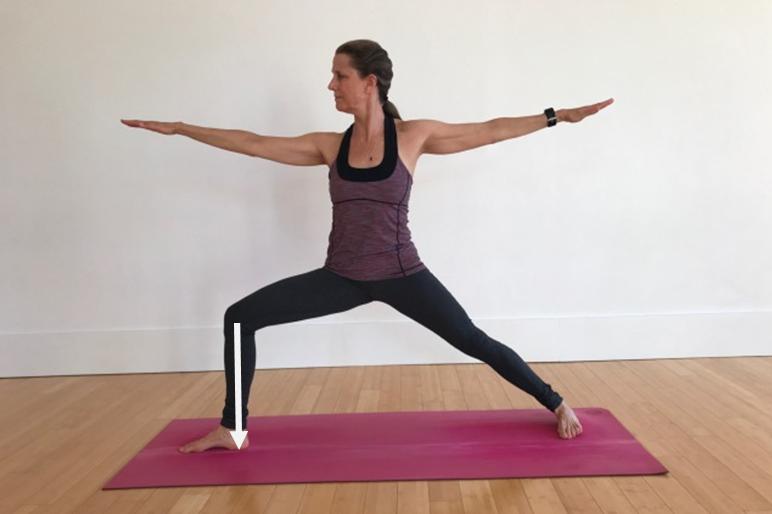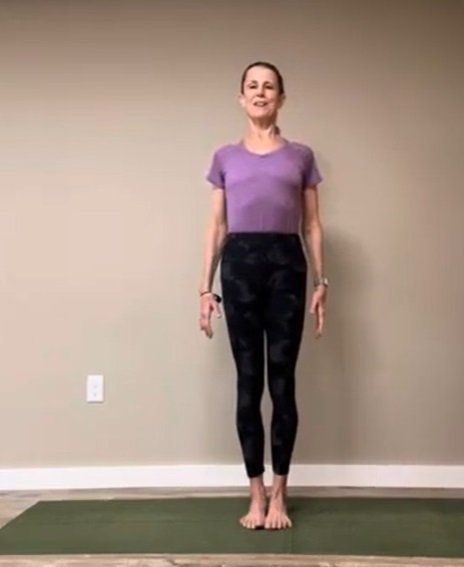In this chapter of Arogya Yoga, we go from Samasthiti – even-standing, to Utthita Hasta Padasana - extended-hand-and-foot-pose, to Virabhadrasana II.
From Samasthiti to Utthita Hasta Padasana
Samasthiti
Utthita Hasta Padasana
BKS Iyengar says that since we spend a good deal of time standing on our feet, we should learn to stand on them symmetrically.
“If the legs are asymmetrical or imbalanced, the body weight is unevenly distributed on the two sides of the body which leads to ailments of the feet, legs and back.”
We learned to stand evenly on two feet last week in Samasthiti (Tadasana). This week we will learn how to step or jump the feet wide apart. What happens when we do this?
First, let’s consider your mat as a grid to help you achieve balance and symmetry in your poses. Take a ruler and a Sharpie and draw a line down the middle of your mat. If you don’t want to mark up your mat, place a yoga belt lengthwise down the middle of your mat. (Just be careful when stepping or jumping your feet apart, the belt can be slippery!) Alternatively, if you are in the market for a new yoga mat, Life form makes mats with alignment marks incorporated as part of the design. You can check them out here.
Stand in the center of your mat in Samasthiti. Bend your elbows and bring your hands up in line with your collar bones. On an inhalation, step or jump the arms and legs wide apart 3-1/2’ to 4’ apart. Keep the feet parallel to each other with the toes pointing straight ahead. Try to land with your ankles as wide as your wrists.
Now look at your feet. Are they even? Arches over the centerline? Or, if you didn’t draw lines, are your toes equidistant from the front edge of the mat? Are the outer edges of your feet parallel to the short ends of your mat?
“If one foot is forward and the other is back, the load on the spinal muscles is unequally distributed.”
Lift the arches of the feet and press the outer edges of both feet on the floor.
“When the arches collapse, the mind becomes inert.”
Lift the inner edges of the legs from the inner knees to the inner groins. Spread and extend the bottoms of the feet from the heels to the toes.
“Constricted toes indicate fear of standing with the legs spread.”
Next, bring your hands up over your collar bones again and on an inhalation, step or jump your arms and legs back together.
Did you land back in the middle of your mat with your feet together and your toes pointing straight ahead? Or, are your feet off center, toes turned out?
Practice jumping in and out until you can land precisely and evenly without correcting yourself afterwards.
“It is a waste of strength and energy to hold an incorrect asana. Accuracy in an asana is a result of precise execution. It is the outcome of correctly implementing the given technique.”
From Utthita Hasta Padasana to Virabhadrasana II
Utthita Hasta Padasana
Virabhadrasana II
There are three parts to learning an asana:
1. Learning the step-wise movements leading to the asana
“This requires fluidity in motion.”
2. Learning to hold the final pose for a fixed duration.
“This requires strength and stability.”
3. Learning the step-wide movements to come out of the pose and back to Samasthiti.
“This requires both fluidity and strength as injuries most commonly occur while getting out of postures because of muscles fatigue.
To come into Virabhadrasana II, start in Samasthiti, Jump the arms and legs apart to Utthita Hasta Padasana.
Using your center line, turn the right leg and foot out 90 degrees. The median of the right leg, i.e., center of the right foot, center of the right knee, center of the right thigh should be in one line. See that the heel of the front foot is in line with the arch of the back foot.
Keep the torso vertical as your bend the right knee to 90 degrees. To achieve this you have to reach more through the left hand as bend to the right. Bend the right leg so that the shin is vertical and the right thigh parallel to the floor. Keep the back leg straight with the inner arch and the knee cap lifting.
“The right thigh and shin must form a proper right angle. If the angle is either acute or obtuse, the alignment of the entire body is disturbed.”
In every asana there is the gross shape of the posture. While this is important, it is only the superficial aspect of the asana. It is important to know what each body part is doing in the pose. This part is very subtle.
When done incorrectly, an asana puts unequal weight on the two sides of the body and the muscles and joints are stretched unevenly. In the beginning, wrong placement of the feet, a collapsed spine, unequal use of the arms and legs, a tilted neck and flaccid muscles are common problems with most adults. It takes time for th body to adjust to the position and the level of precision the asana demands. It is therefore, essential to be patient and diligent while learning asanas.
To read more of the directions for Virabhadrasana II, I’ve attached pages from the book here.





